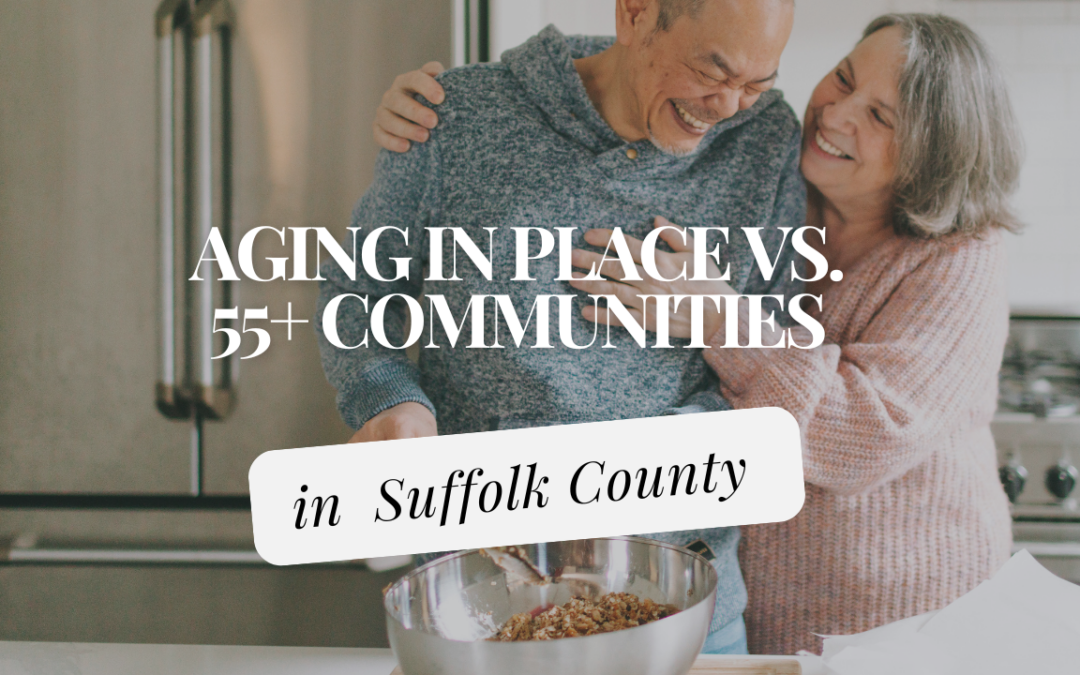Pros and Cons of Aging in Place vs. Moving to a 55+ Community
Suffolk County, NY, offers diverse living options for seniors, leading many to consider the merits of aging in place versus moving to a 55+ community.
Deciding between staying in a familiar home or transitioning to a retirement community involves weighing personal preferences against the benefits of community living. Each option presents its own pros and cons, influencing daily lifestyle and long-term well-being.
Aging in place allows seniors to maintain independence and stay connected to cherished memories in their own homes. Conversely, moving to a 55+ community can provide a vibrant social atmosphere and access to amenities designed for an active lifestyle. Understanding these dynamics is essential for making an informed choice that aligns with one’s needs and desires.
As individuals navigate this important decision, they must reflect on factors such as social connections, healthcare access, and personal safety. Each choice fundamentally shapes the quality of life in later years, making careful consideration crucial for a fulfilling future.
Pros of Aging in Place
- Familiar Environment: Seniors can stay in their homes, surrounded by cherished memories and routines, fostering emotional stability.
- Independence: Allows for control over daily life without community restrictions.
- Cost-Effective: Avoids upfront costs and monthly fees associated with retirement communities, though modifications may be necessary.
- Community Connections: Enables maintaining relationships with long-time neighbors and local friends.
Cons of Aging in Place
- Safety Concerns: Homes may need expensive modifications to accommodate mobility and health needs.
- Isolation Risk: Limited opportunities for new social interactions if mobility or local connections decline.
- Healthcare Access: May require travel for medical services, which could be challenging without reliable transportation.
- Maintenance Burden: Upkeep and repairs may become physically or financially taxing over time.
Pros of Moving to a 55+ Community
- Social Opportunities: Built-in community activities and shared amenities foster engagement and camaraderie.
- Maintenance-Free Living: Landscaping, repairs, and other services are typically included, reducing burdens.
- Healthcare Proximity: Often located near medical facilities with on-site wellness programs available.
- Active Lifestyle: Many offer fitness centers, walking paths, and organized events to promote well-being.
Cons of Moving to a 55+ Community
- Costs: Monthly fees and upfront expenses can be high, which may not fit every budget.
- Age Restrictions: Limits interaction with younger generations or visiting family members.
- Lack of Personalization: Housing and community rules may restrict customization or renovations.
- Cultural Adjustment: Adapting to the community environment and activities might not suit everyone’s preferences.
Understanding Aging in Place
Aging in place allows seniors to remain in their own homes while maintaining independence and familiar surroundings. This concept offers various benefits and challenges that should be carefully considered.
Definition and Concept
Aging in place refers to the ability of older adults to live in their own residences for as long as they are able, rather than relocating to a retirement community or assisted living facility. This approach emphasizes the importance of maintaining independence and staying rooted in familiar environments. It often involves adapting a home to meet the changing needs of seniors, such as modifying bathrooms for safety or ensuring easy access to essential services. Many elderly individuals prefer aging in place as it allows them to retain their privacy, personal belongings, and connections to their community.
Benefits of Aging in Place
The advantages of aging in place are considerable. First, it enables seniors to stay in a familiar environment, which can significantly impact emotional well-being. Familiarity can reduce anxiety and create a sense of stability.
Additionally, aging in place allows for the personalization of living spaces, where individuals can keep treasured possessions and maintain routines that promote comfort and happiness.
Financially, this option can be more affordable than moving to a retirement community, as it typically avoids extra costs associated with such facilities. Furthermore, aging in place can encourage strong social connections with neighbors and friends, enhancing overall quality of life.
Challenges of Aging in Place
While there are numerous benefits, challenges exist as well. One significant concern is safety; homes may not be equipped to handle mobility issues, and falling risks can increase. Installing aids such as grab bars or ramps may be necessary, requiring time and money.
Healthcare access can also become a concern if transportation options are limited. Seniors may find it challenging to visit doctors without assistance, and isolation may become a risk if mobility declines.
Finally, the need for ongoing home maintenance can pose challenges. Older adults may struggle to manage upkeep, which could lead to unsafe living conditions. Addressing these challenges is crucial for those considering aging in place.
Exploring 55+ Communities in Suffolk County, NY
Suffolk County offers various 55+ communities that cater to the needs and preferences of older adults. These communities provide unique amenities and a setting focused on an active lifestyle, allowing residents to engage with peers while ensuring a sense of belonging.
Overview of 55+ Communities
55+ communities in Suffolk County are designed for adults aged 55 and older. They typically include amenities such as fitness centers, pools, walking trails, and recreational activities. Residents can choose from various housing options, including apartments, townhouses, and single-family homes.
Many communities focus on maintaining a vibrant social environment, providing residents opportunities to connect through clubs and events. The appeal of these communities lies in their focus on lifestyle, wellness, and built-in social networks.
Advantages of 55+ Communities
One significant advantage of 55+ communities is the proximity to healthcare facilities. Medical assistance is often readily accessible, giving residents peace of mind regarding their health needs.
Additionally, these communities frequently host activities such as fitness classes, art workshops, and social outings, fostering a sense of camaraderie among residents. Living in a 55+ community often grants access to landscaped gardens, walking paths, and communal areas for social interaction.
Another key benefit is the maintenance-free living that these communities provide. Typically, homeowners enjoy services like landscaping, snow removal, and exterior maintenance, allowing for more leisure time.
Potential Drawbacks of 55+ Communities
While 55+ communities offer numerous advantages, potential drawbacks exist. Some residents may feel constrained by age restrictions, limiting social interactions with younger individuals.
Additionally, many of these communities come with monthly association fees to cover shared amenities and services. These costs can add up and may not be suitable for all budgets.
Furthermore, some residents might find a lack of diversity in interests within the community. While shared experiences can form connections, the potential for limited activities may impact those seeking a broader range of social engagement.
Comparative Advantages
When considering aging in place versus relocating to a 55+ community in Suffolk County, NY, several key areas emerge that highlight the differences. These include social engagement, healthcare access, maintenance responsibilities, and financial aspects. Each factor plays a crucial role in determining the best choice based on individual preferences and needs.
Social Engagement Opportunities
In a 55+ community, residents often benefit from numerous social engagement opportunities. These communities typically offer organized activities, social events, and shared amenities, such as clubhouses or pools.
Participation in group activities can foster friendships and reduce feelings of isolation. Residents may find clubs focused on hobbies, exercise classes, or seasonal events, encouraging regular social interaction.
In contrast, aging in place may limit these opportunities. While individuals can maintain relationships with nearby family or friends, the absence of organized activities can make it harder to meet new people and build a social network.
Access to Healthcare and Services
Aging in place may allow individuals to maintain their trusted healthcare providers. They can continue seeing local physicians and specialists familiar with their medical history. However, as health needs evolve, accessing necessary services may become challenging.
On the other hand, many 55+ communities are designed with healthcare access in mind. They often feature proximity to medical facilities and may even provide on-site wellness programs or services.
Residents might benefit from regular health screenings, fitness classes, or rehabilitation services tailored to seniors. This streamlined access can enhance convenience and promote healthier lifestyles.
Maintenance and Upkeep Considerations
A major advantage of moving to a 55+ community is the reduced responsibility for home maintenance. Such communities frequently include landscaping and property maintenance in their fees, allowing residents to enjoy their homes without the hassle of upkeep.
Aging in place can mean enduring maintenance tasks that become increasingly difficult. Homeowners may need to handle repairs, yard work, and seasonal maintenance, which can be physically taxing.
In a community setting, individuals often find peace of mind knowing their living environment is maintained by professional services. This arrangement allows seniors to focus on enjoying their time rather than managing a property.
Financial Implications
Financial considerations differ significantly between aging in place and moving into a 55+ community. Aging in place may seem cost-effective initially, as individuals can stay in their homes without immediate expenses related to relocation.
However, long-term costs for home maintenance, property taxes, and potential home modifications can accumulate. Homeowners must also factor in the possibility of increased healthcare costs as they age.
In a 55+ community, while upfront costs may be higher due to monthly fees or upfront buy-ins, these expenses typically include amenities, maintenance, and access to health services. This can provide a clearer financial picture and potentially reduce unexpected costs associated with homeownership.
Making the Decision
Deciding between aging in place and moving to a 55+ community involves careful consideration of personal needs, long-term aspirations, and family dynamics. Each individual’s situation is unique, influencing their choice significantly.
Key Decision Factors
- Social Engagement: Aging in place supports established relationships; 55+ communities provide diverse new connections.
- Healthcare Access: 55+ communities offer proximity to services; aging in place may require planning for transportation.
- Financial Considerations: Upfront vs. long-term costs vary greatly between the two options.
- Maintenance Needs: Communities handle upkeep, while aging in place requires self-management or hired help.
Assessing Personal Needs and Preferences
When evaluating housing options, personal needs take precedence. Healthcare requirements often shape the decision. Aging in place might be suitable for those who value familiarity and independence. Those capable of maintaining their homes may prefer staying put.
Conversely, individuals requiring regular assistance may benefit from the amenities offered in a 55+ community. Services such as on-site health care, meal plans, and social activities foster a supportive environment.
Additionally, social needs play a crucial role. Engaging in community activities can enhance well-being and reduce feelings of isolation. Those who thrive on interaction might lean toward a retirement community for richer social engagement.
Considering Long-Term Goals
Long-term aspirations are vital in this deliberation. Individuals should contemplate their future health and mobility. Aging in place might seem feasible today but could pose challenges later. Considering the possibility of decreased mobility, it is essential to assess whether their home will adequately support future needs.
In contrast, a 55+ community often provides more adaptability. These neighborhoods frequently offer varying levels of care, accommodating shifts in health status. This flexibility allows for a smoother transition, ensuring continued support throughout different stages of aging.
Financial aspects are another significant factor. Understanding potential costs associated with either option helps in aligning choices with future goals.
Evaluating the Impact on Family
Family dynamics significantly influence this decision-making process. They often provide support, both physically and emotionally. Evaluating how aging in place or transitioning to a community affects family support systems is essential.
For instance, aging in place may require significant family involvement in caregiving. This can strain relationships and lead to caregiver fatigue. However, maintaining independence can empower loved ones to engage more as companions than caregivers.
Conversely, a move to a 55+ community can alleviate some family burdens. It allows family members to engage in more recreational and social visits rather than being responsible for daily care. Understanding these dynamics ensures that the decision aligns with both personal desires and familial relationships.
Legal and Financial Planning
Effective legal and financial planning is crucial for seniors deciding between aging in place and moving to a 55+ community. This planning involves understanding estate planning, navigating tax implications, and implementing appropriate insurance strategies.
Understanding Estate Planning
Estate planning ensures that an individual’s assets are managed and distributed according to their wishes after death. Seniors should clearly outline their preferences through wills, trusts, and powers of attorney. A well-drafted will can minimize confusion and legal disputes among heirs.
Trusts can offer more control over asset distribution, especially for those with specific wishes for beneficiaries. Additionally, setting up a durable power of attorney allows someone to manage financial and healthcare decisions if the individual becomes incapacitated. Regular reviews and updates to estate plans are advisable, especially after significant life events.
Navigating Tax Implications
Tax implications can significantly affect financial decisions regarding housing. For seniors opting to age in place, property tax assessments may change if they undertake renovations or improve their homes. It’s wise to check local laws in Suffolk County concerning exemptions available for seniors, as they can lead to substantial savings.
Transitioning to a 55+ community may involve different tax responsibilities, including income taxes on retirement funds. Seniors are encouraged to consult a tax professional to understand how moving might influence their tax situation. Strategies like tax loss harvesting or utilizing tax-advantaged accounts can also provide financial benefits.
Insurance and Protection Strategies
Insurance plays a pivotal role in safeguarding a senior’s financial future, whether aging in place or moving to a community. Homeowners should consider homeowners insurance that includes liability coverage to protect against accidents. Those choosing to relocate may opt for renters insurance if they downsize.
Additionally, health insurance needs to be reassessed as care requirements evolve. Medicare and supplemental plans should be reviewed to ensure they meet the individual’s medical needs. Long-term care insurance can also be valuable for those wishing to avoid the financial burden of future health care costs, enhancing peace of mind for both the individual and their family.
Community Insights
Suffolk County, NY, presents unique opportunities and challenges for seniors considering aging in place versus moving to a 55+ community. Understanding local real estate trends and the availability of senior services can significantly impact this decision.
Real Estate Trends in Suffolk County, NY
The real estate market in Suffolk County has shown a shift towards more senior-friendly housing options. Many new developments cater specifically to the 55+ demographic. These communities often feature accessibility features and amenities that appeal to older adults.
Prices can vary, with some areas seeing higher demand owing to location and services available. According to recent data, average home prices in desirable neighborhoods remain high, while more affordable options are becoming available further from urban centers.
Key considerations for potential buyers:
- Location: Proximity to healthcare services and social activities.
- Amenities: On-site facilities like fitness centers, pools, and social clubs.
- Maintenance: Many communities handle landscaping and repairs, reducing the burden on residents.
Availability of Senior Services
Suffolk County provides a range of senior services designed to support independent living and community involvement. These services include home care assistance, meal delivery programs, and transportation services specifically tailored for older adults.
Local organizations and government agencies offer resources such as health screenings and recreational opportunities. Senior centers across the county serve as hubs for social engagement and learning, offering activities that foster community connections.
Essential services available:
- Health Services: Access to geriatric care specialists and rehabilitation services.
- Community Support: Programs to assist with daily tasks and social activities.
- Transportation: Public transit options geared towards making travel easier for seniors.
In summary, the combination of real estate developments and supportive senior services makes Suffolk County a viable option for those considering their living arrangements in later years.
Which is best for you?
Choosing between aging in place and moving to a 55+ community in Suffolk County, NY, involves weighing various factors.
Aging in Place offers familiarity and comfort. Seniors can maintain established community ties and the independence of living in their own homes. However, this option may require home modifications and access to services for support.
Moving to a 55+ Community provides social opportunities and a structured environment. Many of these communities offer amenities and activities designed for seniors, fostering connections. Yet, there may be concerns about leaving behind a longtime home.
Key considerations include:
- Socialization: Aging in place may lead to isolation without proactive efforts to engage socially.
- Financial Implications: Costs related to home maintenance, property taxes, and potential home modifications can vary. In contrast, living in a retirement community typically involves predictability in expenses.
- Health Considerations: Seniors should assess their current health status and future needs. The transition to a community may offer immediate access to healthcare and support services.
Ultimately, the decision should align with personal preferences, lifestyle, and future goals.

Frequently Asked Questions Aging in Place vs Moving to 55+ Community
This section addresses common questions regarding the pros and cons of aging in place versus moving to a 55+ community. Key considerations include advantages of each option, financial implications, and social factors.
What are the key advantages of choosing to age in place for seniors?
Aging in place allows seniors to remain in a familiar environment, maintaining connections with neighbors and their community. It often promotes a sense of independence and comfort, as they are surrounded by cherished belongings and routines. Additionally, in-home care services can be accessed as needed, providing flexibility and support.
How do restrictions such as the 80/20 rule impact living in a retirement community?
The 80/20 rule often refers to the requirement that at least 80% of units in a retirement community must be occupied by seniors. This rule ensures a stable community atmosphere but may limit housing options for younger individuals or families seeking to live nearby.
What potential issues should one consider before moving into an over-55 community?
Potential issues include loss of independence and the availability of necessary services. Residents may face restrictions on home modifications, which can impact their comfort and accessibility. Additionally, the sense of community may vary based on the specific culture of the retirement community.
Are there financial benefits to living in a 55+ community compared to aging in place?
Living in a 55+ community may come with lower maintenance costs, as many handle landscaping and repairs. However, community fees can add up. Aging in place allows for more traditional home equity benefits but may require investment in modifications for safety and accessibility.
How might eligibility requirements, like age restrictions, affect purchasing a home in a 55+ community?
Age restrictions can limit potential buyers, typically requiring at least one occupant to be 55 or older. This can affect resale opportunities and the demographics of the community. Understanding these requirements is crucial for anyone considering a move.
What are the common reasons individuals avoid living in a 55+ community?
Common reasons for avoidance include the perception of loss of independence and social stigma surrounding retirement living. Some individuals may fear that living in such a community could limit their social interactions or lead to isolation. Additionally, costs associated with community living may deter potential residents.
Need Help Selling or Buying a Property in Nassau County? Lisa Adragna Can Help!
Are you thinking about downsizing or selling your home in Nassau County, NY? Look no further—Lisa Adragna is here to guide you every step of the way. With over 14 years of experience in Long Island real estate, Lisa brings a unique combination of motivation, perseverance, and consistency to ensure your home-selling process is smooth, efficient, and successful.

Lisa Adragna
The Top Real Estate Expert in
Long Island, NY
[email protected]
516-707-5489
Affiliated with Compass Real Estate, Lisa has been recognized as one of the “20 Under 40 Rising Stars In Real Estate” by the Long Island Board of Realtors—a testament to her dedication, expertise, and results-driven approach.
Whether you’re buying, selling, or investing, Lisa’s personalized strategies ensure a seamless, stress-free experience.


